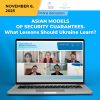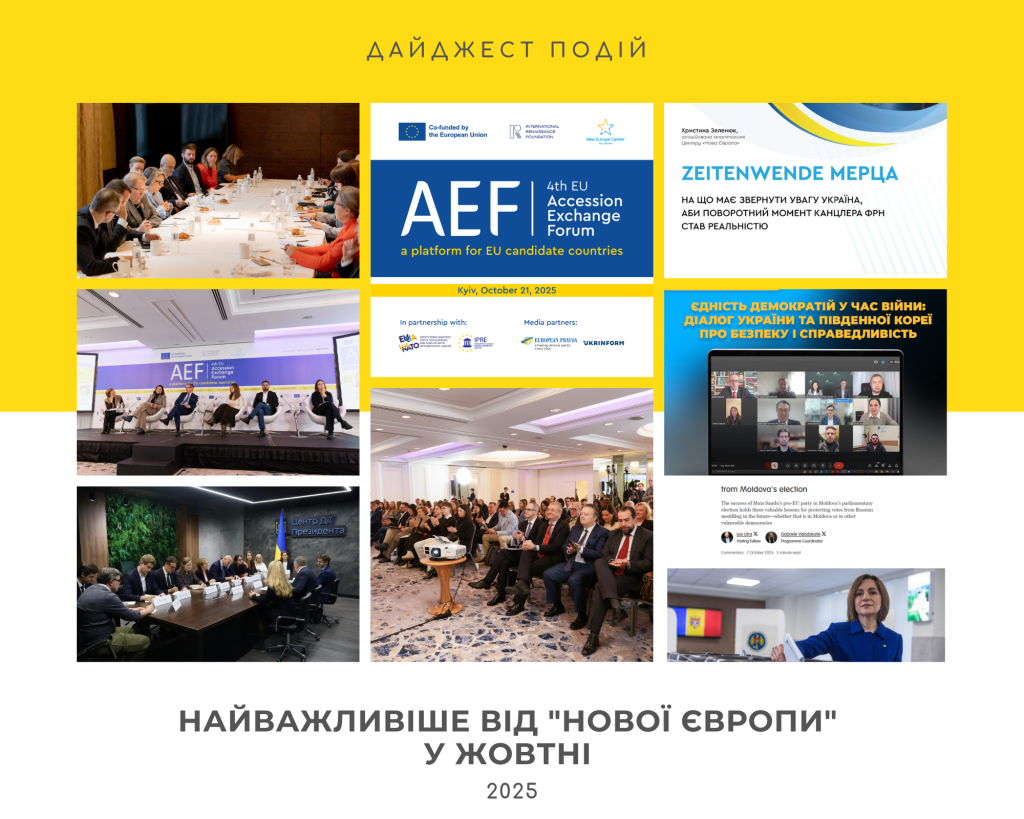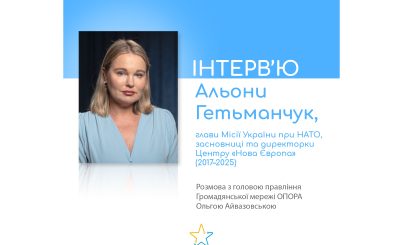Report by Sergiy Solodkyy, First Deputy Director of the NEC, on assessment of Ukraine’s progress in relations with Russia for the quarterly magazine ТRUMAN Index. The full version of TRUMAN Index No. 5 (9) is available on the TRUMAN Agency website.
October-December 2018
Positive points: +1
Negative points: -74
Total: -73
TRUMAN INDEX: -5,56
UPDATE
Pseudo-elections in occupied Donbas, the recognition of a local Ukrainian church, and the attack on Ukrainian naval vessels in the Black Sea were the three events that dominated Ukrainian-Russian relations in this fourth quarter. No signals came of any improvement in the situation and the two countries continued to exchange hostile missives. Both Kyiv and Moscow were talking about the other side’s armed provocations. Russia promised to come up with “an appropriate response,” while Ukraine called it the biggest escalation in armed aggression on the part of Russia since 2014.
Official Kyiv took a proactive position, calling not just for western sanctions to be extended but for them to be increased as well. Ukrainian diplomats began to talk about “creative” sanctions, that is, sanctions that went beyond lists of physical and legal entities. One of these “creative” ideas that might force Russia back to the table, according to Ukraine, would be to ban Russian registered vessels from entering European and American ports.
While Kyiv was thinking about a sanctions upgrade, Moscow for the first time issued its own sanctions list. In a very short time, it managed to issue two related Government resolutions. The sanctions list expanded more rapidly than any of the “select” was able to even figure out why they were on it: sanctions against Ukrainian politicians with a clearly pro-Russian position raise a few questions, as did sanctions against activists who had no assets or business interests in Russia.
The recognition of an independent church in Ukraine forced Russia to react at the highest level: resident Putin even called a session of the RF Security Council on this matter. Kyiv worried about possible provocations, even bloodshed on religious grounds, prior to the Unification Sobor that was to establish the new church.
During this period, the TRUMAN Index reached the lowest level for the entire year. Whereas 2018 started with an Index of 1.30, it has ended with an exceptionally low 4.56. The only other time the Index was so low was at the beginning of 2017, when Ukraine’s suit against Russia came up in the International Court and Russia seized Ukrainian companies in the occupied territories. In short, relations have grown far worse which, given the approach of the presidential election, could well continue through the next quarter as well.
TIMELINE
“Creative” Sanctions in Response to the Kerch Crisis
For many international partners, the escalation of tensions around the Azov Sea that culminated with Russia’s attack on Ukrainian naval vessels on November 25 was quite unexpected and seemed
spontaneous. Ukraine, of course, had been talking about the threat of the inland sea and the militarization of Crimea for quite some time. These concerns came up more and more frequently
after Russia opened the Kerch Bridge in spring 2018. For Kyiv to be prepared for a new round of the conflict required an appropriate reaction that was concerted and determined. Instead, it was seen
as confused or overly ambitious and unjustified.
Ukraine’s diplomats called the new package of restrictive measures that they submitted to the European Union initially “creative” sanctions. Government officials were clearly determined to act proactively this time, not reactively. It was as though the Ukrainian government seemed to want to make up for some of
the shortcomings of previous years, when it reacted to Russian aggression somewhat chaotically and did not show any initiative in dialog with western partners regarding sanctions policies. This new creative approach, for one thing, called for a series of measures. In addition to expanding sanctions against individuals, these sanctions called for NATO vessels to enter the Black Sea and, possibly even, the Azov Sea; for the OSCE SMM mandate to be expanded to cover the Azov Sea; for a ban on Russian ships
entering European and American ports; and for emergency negotiations to take place on all of the existing platforms, including the Normandy format and Minsk. By the end of December, none
of Ukraine’s proposals was carried out by the EU or the US. What’s more, one idea, inviting the vessels of NATO countries, including Germany, to enter the Black Sea, was publicly rejected.
Both public and private statements by EU diplomats demonstrated considerable skepticism towards Ukraine’s new approach. Reaction amounted to: “You’re making things worse for yourselves. The EU
cannot support everything that you have asked for. Russia will see that we aren’t unified on Ukraine’s propositions, and so new arguments will come in handy for critics, who will say that no one supports Ukraine.”
Every one of Ukraine’s propositions really had some limitations that made it difficult to consider the proposal. For instance, to ban Russian ships from European and American ports would lead to financial losses. Europe has always had a strong pro-Russian lobby that knows how to scare their governments about the loss of popularity due to any decline in trade in goods with Russia, although, in fact, trade between the EU and Russia has been growing in recent years. But such proposals should not be rejected
out of hand, either. A number of influential western politicians have talked about this form of sanctions, including Annegret KrampKarrenbauer, the incoming leader of Merkel’s party, the CDU, and a possible future German chancellor.
Kyiv considers the blocking of Russian vessels an appropriate response to Russia’s actions, which include not only attacking three Ukrainian naval vessels and taking their crews prisoner, but also
the constant obstacles Russia has been placing in the way of free navigation of the Kerch Strait and the Azov Sea. Between May and November, Russia stopped more than 110 vessels in the middle of
the sea, unnecessarily held 316 vessels up in the Kerch Strait for permission to navigate into the Azov Sea, and held another 301 up in the Azov Sea when they were going back through the Strait again.
The idea of expanding the OSCE SMM’s mandate to cover the Azov Sea was also raised in the EU, including in Germany. Of course, Kyiv understands that ordinary monitoring of the ports of Berdiansk and Mariupol will achieve little. It won’t stop Russia from interfering in the navigation of merchant ships whose destination is a Ukrainian port, as Moscow will argue that the provisions of the UN Convention
on the Law of the Sea permits this. In this situation, what’s more important is to monitor the situation at the main bottleneck points, such as Kerch, which Ukraine has also proposed.
This proposal also has its limitations. The decision to set up the OSCE SMM was made on March 21, 2014. Even then, the Ukrainian delegation was emphasizing the need to extend the Mission’s mandate to include the Crimean peninsula. But Russia submitted an interpretive statement pointing out the “political and legal reality” that Crimea supposedly no longer belonged to Ukraine and so the mandate could not be expanded to include that territory. Still, Ukraine knows that no matter how Russia responds, it has nothing to lose. If Russia agrees, which is highly unlikely, Ukraine gets one factor to stabilize things in the Azov and the Kerch Strait. What’s more, it would put the issue of Crimea back on the international agenda, since Moscow made it very clear after the annexation that it considered the Crimea question closed.
If Russia rejects this proposition, which is most likely, it will simply confirm, not for the first time, who is really provoking the escalation. This initiative follows very logically from the previous actions taken
by Ukraine and the world community, based on the principle, “The thief’s hat is on fire.” For instance, an international tribunal was formed to judge the organizers and executors of the shooting down of MH17 in July 2014 and Russia blocked the idea. When Ukraine insisted on carrying out the September 5 Minsk protocol on continual monitoring of the Ukrainian-Russian international border, Russia refused to comply with that, too. Back in 2015, Ukraine’s president first proposed setting up a UN peacekeeping mission in the Donbas to get the situation under control, and Russia categorically rejected the idea. Only at the end of 2017 was some agreement reached, but with significant caveats. So Russia’s rejection of Ukraine’s proposition regarding the OSCE SMM in Kerch will be just another reason to turn to the EU to ask for stronger sanctions…
The Budapest Memorandum and the Election
After Russia’s attack in the Black Sea outside the Kerch Strait, Ukraine immediately raised the issue of security in the Azov Sea on every international platform it could. That included, as usual, the OSCE
and UN Security Council, but also those that are strictly involved in resolving the conflict in the Donbas: the Minsk and Normandy formats. Russia rejected these formats, emphasizing that Moscow was only an intermediary in what was a “civil war” in Ukraine.
In addition, Ukraine immediately called for immediate consultations with the signatories of the Budapest Memorandum. This time, Kyiv was better prepared to possible criticisms of the initiative. Earlier, considerable skepticism had circulated around the binding nature of this document—even Ukraine’s closest allies pointed out that the document contained not “guarantees” but “assurances.” This time, Ukraine’s diplomats kept referring to international law, emphasizing the importance of fulfilling the memorandum. They reminded their partners about Art. 26 of the 1969 Viennese Convention on
international contract law, which states that every valid contract is binding on its parties and is supposed to be upheld in good conscience. Moreover, in the Russian language version, the Budapest Memorandum actually refers to “obiazatelstva,” meaning obligations or commitments, which has greater legal force than “assurances.” For this reason, Kyiv dismisses claims by the Russian leadership about
the non-binding nature of the memorandum.
Still, Ukraine’s diplomats admit there is one serious flaw in the document: there is no clear mechanism for enforcing its provisions. The memorandum talks about consultations, but the procedure for calling for and holding them is not specified. The first talks by the signatories of the Budapest Memorandum took place in Paris on March 5, 2014, and Russia simply refused to show up. And so Ukraine has continued to propose that Russia, the US, Great Britain, China, and France hold consultations. London agreed in principle. The US, France, and China felt that the full format needed to be maintained and so, with Russia refusing, it’s impossible to make the Budapest Memorandum work.
Even if Ukraine’s politicians had no election goal in mind, their reaction to the November 25 attack will have an impact on voters, regardless. Thus, the failure to get the Budapest Memorandum on the table has hurt the nominal leader in the presidential race, Yulia Tymoshenko. She proposed a “Budapest+” format to include the EU and Germany. The declaration of martial law in 10 oblasts was received with some suspicion in the West as a move that could be used to delay the election. In Russia itself, both the Kerch crisis and Ukraine’s reaction to it were tied entirely to the election cycle as supposedly convenient
for Petro Poroshenko.
Sanctions Galore: Russia’s Carrot and Stick
Throughout the quarter, Ukraine kept warning that Russia was planning destabilizing actions during the election campaign period. Kyiv treated Russian sanctions against individuals and businesses as a kind of “carrot and stick” approach by Putin, with the stick meant to punish businessmen who support the incumbent and the carrot is the possibility to be removed from the list.
The impression is that no one in Ukraine took Russia’s sanctions especially seriously. Those who made it on the list bragged about it. Their campaign headquarters immediately began to analyze the list for why one candidate or another might be on it: absence was supposed to suggest some kind of deal with the Kremlin. And so the president’s team had to try to explain why Poroshenko and his foreign minister weren’t on the list. However, even being on the list didn’t offer any clear benefits: the press was awash with rumors that some candidates had been left off by Moscow in order to remove any suspicion of covert cooperation.
For the first time, Russia put individuals on its sanctions list. So far, it had only restricted certain sectors of Ukraine’s economy. Moscow had engaged in a kind of “economic punishment” towards Ukrainian
businesses long before the war. For instance, it restricted imports of farm products from Ukraine during the intensive period of talks between the EU and Moscow loyalist Viktor Yanukovych regarding the Association Agreement in 2013. The price of natural gas and deliveries of it were one of the most obvious levers used by Moscow to get Kyiv to the table. There were also occasionally restrictions on individuals, although they were never published so no one knew if they were an FSB blacklist: the person would only find out when they tried to cross the border into Russia.
In addition to the approaching election season, there was no reason for Russia to change its position. This “happenstance” was anything but coincidental to many observers in Ukraine. In early November,
economic measures were instituted against 322 Ukrainian citizens and 68 companies. By the end of December another 200 individuals and companies had been added to the list. Moreover, even some
former members of Party of the Regions joined the list, who could never be accused of not being loyal to Russia.
Ukraine’s list of sanctions is far longer than the Russian one. In May, the Poroshenko Administration published an updated list of sanctions against Russia that included 1,748 individuals and 765 legal
entities. A year earlier, the list had contained 1,228 persons and 468 companies. Among the individuals are Gazprom boss Alexei Miller, aluminum tsar Oleg Deripaska, billionaires Igor Rotenberg and Viktor Vekselberg, investor Suleiman Kerimov, oil tycoon Vladimir Bogdanov, and banker Andrey Kostin.
The “carrot” in Putin’s decree is that sanctioned restrictions might be lifted. So Russia’s MinFin is responsible for submitting proposals to “offer temporary permission to carry out specific operations in
relation to specific legal entities against whom special economic measures are in place.” And so individual companies can look to Ukrainian voters and the government as though they are victims of
Russian sanctions, when in fact sanctions may not actually extend to them—and it’s unlikely that the press will publish the news about such “temporary” suspensions of sanctions.
Other than the election campaign, some have seen other reasons behind Russia’s radical actions, including the steps Kyiv took to get an independent Ukrainian Orthodox Church recognized.
Tectonic Religious Shifts
The Unification Sobor that took place December 15, 2018, to establish a unified Ukrainian local Orthodox Church was one of the main events, not only of the last quarter, but probably for the last more than 300 years: the Kyiv Metropole was moved to the Moscow Patriarchate in 1686. For the Western world, which gravitates to the secular and associates religious dogma with the Middle Ages, the attention Ukraine’s political elite paid to religious matters probably looked a bit odd. In Ukraine, however, the Russian Orthodox Church was always recognized as a serious source of influence. In the Russki Mir initiative that was supposed to spread Russian cultural and political concepts, orthodoxy figured prominently. One of the most influential personalities in Russia, Patriarch Kirill I officially supported the ideology of Russki mir, taking on himself the function of its defender and conductor. Back in 2009, he said that the core of Russki mir were Russia, Ukraine and Belarus, “regardless of state borders, political disagreements, spiritually, and I emphasize spiritually, we continue to be a single people. And most of us are children of the Russian Orthodox Church.”
From the very start of Russia’s aggression in 2014, Kyiv saw the Russian church as an integral part of Moscow’s efforts to destabilize Ukraine. But the initiative of the government to establish an independent canonical church was a complete surprise. Even more surprising, especially for Moscow, was the process through which Ukraine’s leadership was able to foster the unimpeded establishment of a national church.
The circle of politicians involved in this was not large. The country’s leadership understood the kind of threats that would stand in the way to achieving autocephaly and so it limited the flow of information. The Presidential Administration and later the National Institute of Strategic Studies, whose director is one-time Assistant Chief-of-Staff Rostyslav Pavlenko, and the Foreign Ministry. Without the intermediation of the government and the support of the Ecumenical Patriarch, the idea of a local church could have collapsed many times, and not always because of interference from Russia. Russia, of course, was involved in countering the autocephalous process at every possible level: church, politics, and media.
Indeed, some of Moscow’s intended effects came to fruition. For instance, the majority of the hierarchy of the Ukrainian Orthodox Church of the Moscow Patriarchate refused to participate in the Unification Sobor. This already gave Russia the opportunity to talk about the schismatic nature of the actions of Ukraine’s politicians. Moreover, it also establishes fertile ground for further maneuvers using the church as an instrument for influencing the situation in the country.
Ukraine’s politicians were worried about Russian provocation, which could have involved bloodshed, even as they prepared for the Unification Sobor, such as the tragic events in Odesa during the May holidays in 2014. A few days prior to the convention, the SBU announced that it had prevented some provocative actions that supposedly were to be organized by an Anti-Maidan activist who was hiding in Moscow. The Russian Foreign Ministry claimed that this was a fake. At that point, SBU officials called on Ukrainians not to give into any provocations to avoid becoming “cannon fodder to satisfy the imperial ambitions of the puppetmaster behind the wall.”
Although the country’s leadership in public acted confident that it had the situation in hand, official Kyiv understood: Russia continues to have opportunities to make subversive moves. The Ukrainian government is most worried that the shift of MP churches to the new national church could also be accompanied by bloodshed, because Russia is prepared to discredit their actions as incitement to a religious war.
Minsk Regress: Meetings = +100 Real Results = ~0
Over this last quarter of 2018, the Minsk process saw its hundredth meeting come and go, but no one really noticed this jubilee event. This format of negotiations has long languished in stagnation: Russia openly refuses to negotiate with the current Administration, while Ukraine also sees no point in compromising since none of the previous compromises led to peace.
Yet, the negotiating process itself raised the emotional temperature more than once. The pseudo-elections that took place in occupied Donbas could have finally killed the already half-dead talks. Indeed, voices were raised in Kyiv to say that it was time to leave the Minsk process because of the pointlessness of any negotiations with Russia. There were also worries that the Verkhovna Rada would find itself in heated debate over prolonging the Law on the special status of certain counties of Donbas. Surprisingly, international observers said the vote took place without any to-do.
Other concerns emerged over problems with continuing the work of the Trilateral Contact Group, because Leonid Kuchma no longer wanted to represent Ukraine. The Russian press spread rumors that Ukraine would now be represented by another ex-president, Viktor Yushchenko. This was hardly likely to raise confidence among European partners: Chancellor Merkel found it quite difficult to engage in a dialog with him. But, once again, Ukraine prevented accusations that it was disrupting the Minsk process. The decision was made that Yevhen Marchuk, a former premier, would represent Ukraine at the talks. Marchuk has considerable experience working on security issues, and he knows Russia’s political elite and its methods very well. This kind of background could ease the negotiating process, provided that it takes place. Based on Marchuk’s public statements, the Russian side has been tasked with sabotaging the consultations at least until the presidential election is over. Putin, for instance, refused to even negotiate over the phone with Poroshenko over the Kerch incident. He also stated point-blank that it was pointless to keep communicating in the Normandy format.
The pseudo-elections in the occupied territories had a harsh reaction from Ukraine. Officials close to the negotiation process kept hoping until the very end that Putin would go for a compromise at the last minute and refuse to organize the election of new leaders for the occupied territories. This would have improved dialog with the West and soften EU sanctions that were up for renewal in December. But once again there were voices raised against any compromise, in part because Moscow has no wish to make the current leadership in Kyiv any “presents.” Kyiv understands that Putin will not back down because he has a clear objective: to force his own vision of a solution to the situation through direct talks between Kyiv and the militants running the occupied territories.
This same spirit can be seen in the question of exchanging hostages and releasing the Ukrainians Russia is holding as prisoners of war and political prisoners. Ukraine’s negotiators say that Russia is using the question of releasing its hostages for political purposes. If this does happen, then it will be in such a way as to give the least credit possible for it to Ukraine’s leadership.
This last quarter was quite uneasy because of the real threat of a fullfledged war: Russia kept accusing Ukraine of preparing provocations and Ukraine kept warning that the risk of escalation on Russia’s part was the highest since 2014. Russia’s MFA officials reported about preparations for “provocations by Ukraine’s forces in the Donbas.” Later, FM Sergei Lavrov said that he expected provocations at the administrative border with Crimea. President Poroshenko meanwhile reported that Russia had deployed some 80,000 soldiers to the Ukrainian border, nearly 1,400 pieces of artillery and missile systems, 900 tanks, 2,300 armored vehicles, and over 500 aircraft.
The next quarter is expected to be especially tense as the presidential election looms in Ukraine. Moscow understands that the chances of a loyal candidate coming to power in Kyiv are low. However, it remains interested in the results and clearly would like very much for the current president to lose.







